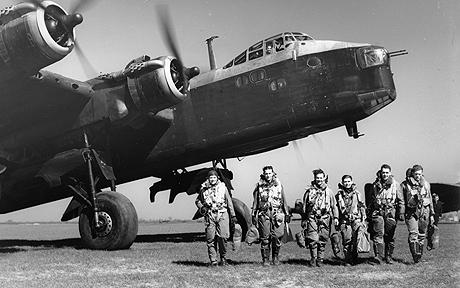The 49 Sqdn left from Fiskerton at 1943-03-06 at 19:20
He flew with a Avro Lancaster (type III, serial ED431, code EA0M).
Campaign report of the USAAF:
(Eighth Air Force): VIII Bomber Command Mission No. 40: 71 B-17's of the 1st Bombardment Wing are dispatched against the power plant, bridge and the port area at Lorient, France; 65 drop 162.5 tons on the target between 1441 and 1445 hours local. We claim 7 aircraft destroyed, 2 probably destroyed and 1 damaged; we lose 3 B-17's and 8 others are damaged; casualties are 30 MIAs. Fifteen B-24's of the 2d Bombardment Wing fly a diversionary mission against the a bridge and the U-boat facilities at Brest, France; all 15 drop 44.5 tons of bombs at 1416-1417 hours local. We claim 2 aircraft destroyed and 2 damaged; 3 B-24's are damaged but there are no casualties.
Campaign report of the RAF:
5/6 March 1943
Essen was the target for 442 aircraft - 157 Lancasters, 131 Wellingtons, 94 Halifaxes, 52 Stirlings, 8 Mosquitos - in the first raid of the 'Battle of the Ruhr'. It was on this night that Bomber Command's 100,000th sortie of the war was flown. 14 aircraft - 4 Lancasters, 4 Wellingtons, 3 Halifaxes, 3 Stirlings - lost, 3.2 per cent of the force.
The only tactical setback to this raid was that 56 aircraft turned back early because of technical defects and other causes. 3 of the 'early returns' were from the 8 Oboe Mosquito marker aircraft upon which the success of the raid depended but the 5 Mosquitos which did reach the target area opened the attack on time and marked the centre of Essen perfectly. The Pathfinder backers-up also arrived in good time and carried out their part of the plan. The whole of the marking was 'blind', so that the ground haze which normally concealed Essen did not affect the outcome of the raid. The Main Force bombed in 3 waves - Halifaxes in the first wave, Wellingtons and Stirlings in the second, Lancasters in the third. Two thirds of the bomb tonnage was incendiary; one third of the high-explosive bombs were fused for long delay. The attack lasted for 40 minutes and 362 aircraft claimed to have bombed the main target. These tactics would be typical of many other raids on the Ruhr area in the next 4 months. Reconnaissance photographs showed 160 acres of destruction with 53 separate buildings within the Krupps works hit by bombs. Small numbers of bombs fell in 6 other Ruhr cities.
7 aircraft of No 4 Group were sent minelaying in the Frisian Islands without loss.
With thanks to the RAF and USAAF.net!
This record can also be found on the maps of Back to Normandy with Google coordinates. You can find the maps by clicking on this link on this location.
There are several possibilities to investigate the flight records on Back to Normandy. All the flights are plotted on maps, sorted "day by day", "by squadron", "by type aircraft", "by year or month", "by location" and much more! Don't miss this!!!
If you have any information that you want to share, please add your comment at the bottom of this record. Or send your information to [email protected]. This information will be added to the record.
Your photos and your information are very welcome! The young do care and with your help we keep up the good work.



